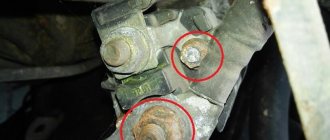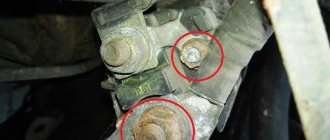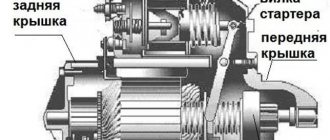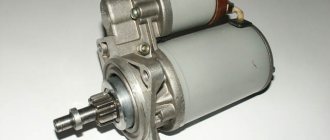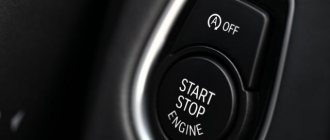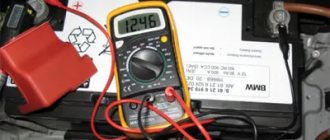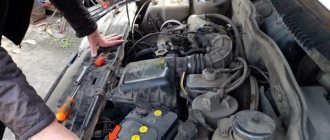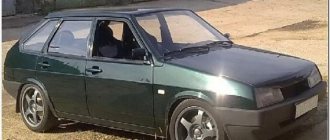Car enthusiasts often wonder: how to close the starter with a screwdriver to start the engine
? And it occurs when the motor refuses to start due to the fact that the starter contacts are covered with an oxide film (strong dielectric), which prevents the normal flow of current. It becomes difficult to start the car without assistance.
Every car owner should know how to close the starter with a screwdriver in order to avoid trouble starting the engine. But before you learn this, you need to understand that this method is not effective in all cases. First you need to identify the causes of the malfunction.
In order to close the starter, you will need a screwdriver, wrench or other metal tool. In our case, consider the option with a screwdriver and a faulty retractor relay.
Problems with the retractor relay are indicated by a peculiar click under the hood when you turn the key in the ignition. The clicking sound is a signal that the solenoid relay is turned on, but the overrunning clutch cannot turn the crankshaft. There is only one way out - close the starter so that voltage goes to the winding.
First you need to choose the right screwdriver
so that its length matches the distance between the terminals that will be closed.
Next, the gearbox is placed in neutral gear
, the handbrake is tightened all the way, the key is inserted into the ignition switch and turned in the desired direction.
After which the starter terminals are short-circuited. The key and the screwdriver work instead of the faulty relay, and the Bendix turns the crankshaft. As a result, the long-awaited engine start occurs.
Overall the method is simple
. But owners of cars from the 80s and 90s need to know that in contactless ignition systems, the switch controls the voltage supply to the coil, but in older ones there is no such control, and when the starter closes, the coil may break.
If you have to close the starter in the contact system, it is better to do it together
. One will need to turn the key in the ignition, and the second will need to close the starter contacts.
More experienced car enthusiasts know that the car may not start for a number of reasons that have nothing to do with the starter. But still, most often the “dog is buried” in it.
To clearly understand the essence of the problem, you should familiarize yourself with common starter malfunctions, which include:
- burnt winding;
- malfunctions in the relay;
- wear of the overrunning clutch (Bendix);
- oxidation of contacts.
With all these breakdowns, the engine will start with difficulty or even refuse to start. It is in this situation that you need to take action.
In principle, everything is clear with the main question. The entire procedure for closing the starter is accessible and does not require special knowledge and practice. But most people may be wondering why the starter does not want to start the internal combustion engine?
The fact is that the solenoid relay has a solenoid, an electromagnetic coil and a contact group in its design. The latter, in turn, has a washer and two bolts (copper).
This simple process powers a car engine.
But when the above-mentioned contacts oxidize, current can no longer pass through them, which means that the necessary charge of electricity does not reach the winding, as a result of which the car does not start.
In this case, to start the internal combustion engine, you can use several proven methods, such as: closing the starter with a screwdriver, asking your garage or parking lot mates to push the car (start it with a pusher) or take it in tow.
Three ways to close the starter directly
- Three ways to close the starter directly
- Basic starter failures
- Close the starter from the pushrod
- Towing a car
- Closing with a screwdriver
Many motorists have encountered such a problem as starter failure. It can break at any moment. How to start a car if the starter does not work, but you need to drive? It is possible to start the car in this way by either closing the starter directly or starting without it. But before you do this, you should familiarize yourself with the main breakdowns of the starter and understand all the nuances.
Turning on the starter directly from the battery
ATTENTION! A completely simple way to reduce fuel consumption has been found! Don't believe me? An auto mechanic with 15 years of experience also didn’t believe it until he tried it. And now he saves 35,000 rubles a year on gasoline! Read more"
To make a direct contact with your own hands, you just need to get a piece of copper cable, a connector and an alligator clip. These three components are used to solder a device that will run the starter directly from the battery.
- Under the hood of the car, near the right headlight, there is a red wire with a plug that needs to be disconnected and the prepared cable with a connector inserted into it;
- The car is idled;
- The ignition is turned on;
- The crocodile connects neatly to the positive side of the battery.
These manipulations are often enough to start the starter if it is working and has no other problems. After the car starts, the crocodile needs to be thrown off the plus side.
It is recommended to always keep such a homemade device with a connector and a crocodile in the trunk as a last resort. After using it, it is simply pulled out, and the previously removed plug is put back in place. Everything is easy and simple, except for one thing - you need to work carefully so as not to get burned or short circuit something else.
Basic starter failures
The starter ensures the engine starts. It creates crankshaft torque at the required speed for the degree of compression and combustion of the combustible mixture. If the starter starts to work intermittently, you need to find out the reason for this behavior.
If the starter does not want to turn or does it slowly
- pay attention to the electrical circuit and battery:
- The battery is not charged;
- contacts are poorly secured;
- poor contact and broken wire from the solenoid relay terminal;
- damaged wire between battery and starter;
- mismatch of oil in the crankcase in terms of viscosity;
- The ignition switch contact group is not functioning.
If the starter does not work or simply does not turn on,
this could be: a relay malfunction, a short circuit in the winding of the starter itself.
If the starter armature rotates, but the starter cannot crank the crankshaft
this is: slipping of the freewheel or tight running of the screw thread drive.
There are times when the starter does not turn off after starting.
The reasons may be: drives jamming on the armature shaft, jamming in the ignition switch, bearing wear. Such breakdowns can be corrected by replacing damaged parts.
If you notice that the starter has started to make noise.
This could be: the drive gear is out of mesh, the fastening or the starter poles are loose.
The starter is subject to heavy loads, since it has to rotate a large flywheel and drive the engine piston group. Therefore, you should treat it carefully and carry out diagnostics to avoid breakdowns.
Causes of starter malfunction
If, when you try to turn on, the starter still shows signs of life, for example, you can hear its armature spinning idle or an unpleasant sound is heard when the Bendix overrunning clutch slips, then the failure of the unit is mechanical in nature. That is, there is a failure of the fork, overrunning clutch or planetary gearbox (if any). In this case, you will not be able to start the car if the starter does not work. It will have to be removed and repaired, and the launch will be carried out “from the pusher”.
Car starter circuit
If the flywheel turns too slowly, it is a sign that the armature is touching the stator. As motorists say - “shoes”. This happens due to wear of the armature sliding bearings - bushings. Moreover, if you operate the starter for a long time with worn bushings, then the armature winding plates, constantly “clinging” to the stator, will begin to shift, damage the winding wires and a short circuit will occur. In order to narrow the scope of troubleshooting when it is associated with a power supply failure, car repair shops often use this method to start the starter, such as shorting the terminals of the “positive” wires connected to the solenoid relay. If the attempt is unsuccessful, then the fault should be looked for inside the starter. Its cause may be:
- Worn or stuck brushes.
- Broken wiring in the solenoid relay.
- Broken stator or armature windings.
- Burnt contacts of the solenoid relay.
The starter working as a result of such a “direct connection” will be a clear indication that the electrical circuit is broken outside the unit, that is, the following options are possible:
- Broken contact group of the ignition switch.
- Failure of the starter switch relay.
- Break or short to ground of the positive wires.
- A break in the “mass” wire of the engine or severe oxidation of its terminals.
This starting method is suitable not only for diagnostics, but can also help out in cases where there is no time to repair the car, but you still need to drive.
Closing with a screwdriver
Closing the starter with a screwdriver can only be done if the cause of the breakdown is the solenoid relay.
You can recognize such a breakdown
by the clicking sound coming from under the hood when you turn the key.
This means that the retractor relay is turned on, but the drive gear does not turn the crankshaft. In such a situation, nothing can be done other than jumping the starter with a screwdriver and thus applying voltage to the windings. This is interesting: Painting a car with liquid rubber
To close the starter using a screwdriver, you need to set the gearshift lever in the neutral position and tighten the brake. Under these conditions, the screwdriver will act as a pull-in relay. We insert a screwdriver between the power terminals, closing them.
In order to start the car directly through the starter, it is best to resort to the help of an assistant. So this will make things easier. One will insert the screwdriver, the other will close the contacts. With an assistant, everything will go much faster and easier.
Subscribe to our feeds on Facebook, Vkontakte and Instagram: all the most interesting automotive events in one place.
The third method is closure
And finally, we come to the actual topic of this article: correctly closing the starter with a screwdriver. In this case, brute physical force or towing is not needed. It will be enough to arm yourself with a simple screwdriver, preferably with a long handle. Before moving directly to the process algorithm, let's dwell on the question: what is better to close the starter - with a screwdriver, wrench or pry bar? Let us note right away that a mount is an option for a rainy day when you don’t have a screwdriver or a key at hand. As a rule, a screwdriver and a wrench help in cases where the relay is faulty. The characteristic clicks coming from under the hood when turning the key in the ignition are full confirmation of this. The Bendix gear is not able to turn the crankshaft because the relay does not provide enough energy. It remains to close the starter, giving voltage directly to the windings. As mentioned above, it is advisable to arm yourself with a large screwdriver or wrench that would reach both power terminals of the relay in order to bridge them. Don’t forget to set the gearbox lever to idle and tighten the handbrake all the way. The key in the ignition switch must be turned half a turn so that the corresponding lights on the instrument panel come on. A screwdriver attached to the terminals in this case works like the relay itself. The method, as we see, is not tricky. But you must always be on your guard. The fact is that you can damage the coil. It easily fails if you do this several times in a row. It’s just that on classic contact systems the coil does not have the appropriate protection, as on non-contact systems. To protect the coil from burning out, it is recommended to do the following:
This is interesting: How do the newly minted ministers live and, in particular, what do they drive?
- Ask the assistant to get into the car;
- Have him put the ignition key in the ignition position while you close the contact.
Thus, having learned how to revive the starter yourself, you can safely go to the longest distances.
The problem will be solved in one minute. But then it will be necessary to visit a car repair shop, where the starter will undergo a thorough diagnosis by specialists. They will immediately determine the cause, eliminate it, and you will no longer fall under Murphy's Law. Although no one can guarantee that this will not happen after a certain period of time.
how to close the starter directly on a VAZ 2109
Hello, dear car enthusiasts! Many of us motorists have at least once in our lives found ourselves in a situation where the car starter stubbornly refused to fulfill its intended purpose. According to the well-known Murphy's law (in common parlance, the law of a falling sandwich), such troubles happen at the most inopportune moment, you have to go, and time is running out. In such cases, there is nothing left to do but start the car without a starter or close it directly and hit the road.
Before closing the starter directly, diagnostics are advisable. Before taking decisive action, it would be a good idea to try to identify them, because some of them can be eliminated on the spot yourself. The most difficult starter failures include: a faulty, burnt-out starter winding. If you have diagnosed one of these complex breakdowns, you can immediately begin to look for a way to start the engine with a non-working starter.
These methods are few, but they work flawlessly. The essence of the first simple and reliable way to start a car without a starter is that several strong, sympathetic neighbors in the garage rest their hands on the trunk of the car and, on command, begin to accelerate. While you are driving, you turn on the ignition key and first gear. The more active the pushers are (in terms of acceleration speed), the faster the engine will start.
This method of starting a car is called push-start and is the most popular among car enthusiasts. The second most popular and effective auto-folk method for reviving a car engine is towing. It consists in the fact that your car is towed by another car for some distance using a cable. You need to exercise maximum caution in this case: first, keep in mind that when your car starts, it will definitely begin to accelerate. Secondly, when the car in front of you stops, do not forget to stop your car. Finally, do not turn off the engine when you get out of the car to unhook the cable, otherwise you will have to repeat the entire procedure.
How to start a car without a pushrod and a cable? Just close the starter. You can try to bring the car back to life without using brute physical force. To quickly complete the task, you need to have an idea of how to close the starter directly. Let's figure out how to start the starter directly or, in auto-folk language: how to close the starter with a screwdriver, wrench, pry bar or other suitable means at hand.
It is worth mentioning right away that a screwdriver and a wrench will only help if the cause of unsatisfactory operation of the starter is a malfunction of the solenoid relay. You can recognize it by the characteristic patterns when you turn the key. This sound indicates that the retractor relay has been turned on, but the Bendix drive gear cannot crank the engine crankshaft. There is no other way out of this situation except to bypass the starter and apply voltage to the windings. So, in order to close the starter you will need a large screwdriver or wrench with a gap corresponding to the distance between the power terminals of the solenoid relay, with which you will simply need to close them. But first you need to set the gearshift lever to neutral and tighten the brake to full.
The key in the lock must be in the appropriate position. Under these conditions, the screwdriver (key) will act as a retractor relay. In these simple ways you can start the car without briefly racking your brains over the question: how to close the starter. The only point in this technology is when starting the starter directly on the contact ignition system, make sure that the coil does not fail. After all, if on a contactless ignition system the switch monitors the supply of voltage to the coil, then on classic contact systems there is no such protection. On contact systems, it is more convenient to perform such actions with an assistant: one puts the key in the ignition position, the second closes the contact.
Diagnostics
It is necessary before the motorist wants to take active action. If you can identify the reasons for this behavior of the starter, then they can be eliminated right on the spot, without even going to a car service center and without wasting extra time. The basics of starter repair teach us that the most complex breakdowns are the following:
- The starter relay has failed;
- The solenoid relay has deteriorated;
- The bendix is worn out;
- The starter winding is burnt out.
If at least one of the above breakdowns is confirmed, you have to look for ways to start a car with a non-working starter. They exist, but they are very few. But they will help you cope with the problem 100 percent.
Functional features of the starter
Unfortunately, the service life of the device does not differ in duration compared to the period of operation of the power unit. On average it lasts about 5 years. It is extremely important to pay attention to the diagnostics of the device both on a newly purchased vehicle and on a car with a significant mileage, since this measure will help in the future to significantly extend its life.
In the design of the engine starting system, the starter spins its crankshaft, which creates the necessary degree of compression for the correct formation of the mixture and its combustion. Since the device works in conjunction with various mechanisms and electronic systems, it can therefore experience both mechanical and electrical failures. When the starter turns the crankshaft slowly or does not turn it at all, most likely the power source needs to be recharged, there is no contact in the vehicle's on-board network or in the ignition switch. Sometimes the cause of the malfunction is so trivial that the breakdown can be eliminated by simply cleaning the contacts from dirt and oxide deposits.
If the device does not function completely, it is quite possible that the traction relay has failed, or the winding on the coil has burned out. When the clutch slips, the starter does not start the power unit, while its armature rotates. Mechanical damage to the shaft, wear of bearings and problems with the ignition switch lead to the fact that even after starting the engine, the starter still continues to work.
The engine starting device is constantly subjected to high loads, due to the fact that it has to be aggregated with a large and heavy flywheel and rotate it to start the piston part, for this reason you should not neglect to diagnose the device and follow the proper rules for its operation.
It is necessary to accurately determine the reason for the incorrect operation of the starter, since it is not always possible to start the power unit in this way.
Scheme, theory and practice
Let's see what the wiring diagram of any electric starter looks like. Contact B is constantly supplied with voltage.
Starter and its external circuits
In the diagram we see three “positive” contacts and one negative (8), which is always connected to the body. What needs to be closed:
- Before closing the starter, locate the S terminal. It is often made in the form of a petal;
- How to distinguish contacts B and M: the first will have a potential of “+12”;
- You need to close contact B with terminal S. This is done briefly and after turning on the “neutral”;
- Contacts M and B cannot be closed.
We move from theory to practice. On a VAZ-2114 car everything looks simple.
Solenoid relay VAZ-2114
Terminal B here is covered with a rubber band, and petal S is in contact with the terminal in plastic. The plastic plug is removed before “shorting”.
Closing the starter contact with a screwdriver
Make sure that the metal of the screwdriver does not touch the relay body when closing. Otherwise, we will simply close the “+” contact to “ground” (dangerous). All work is carried out with the ignition on.
Explanation of symbols:
- B – Bold, “thick” wire;
- M – Motor (electric motor);
- S – Start.
How to close the starter from the pushrod?
Thus, it is possible to start a car engine if the traction relay or the starting device winding is faulty. This method is considered the most common among motorists. In order to start the starter from the pushrod, you will need a couple of assistants who will push the car, resting their hands on the trunk. At this time, the driver engages first gear and turns the key in the ignition. The starter should start the power unit.
This is interesting: Where do the cars that remain unsold go?
Note that the greater the acceleration of the car while pushing, the faster the engine starting device will begin to spin its crankshaft, and the faster the car will start.
Starting the engine while towing a vehicle
This is another common method for starting a car engine with a faulty starter.
Important! This method is not suitable for vehicles equipped with an automatic transmission, since due to certain features of its design, towing the vehicle is strictly contraindicated.
To implement this method, you will need a tow rope and another car. It is extremely important to strictly follow the following sequence of actions during towing:
- the leading machine should start moving smoothly and start moving at low speed to tension the cable;
- the driver of a towed car should not brake sharply;
- after the vehicle starts, it will begin to accelerate sharply;
- you should stop only after the leading car stops;
- Do not turn off the engine while unhooking the cable, otherwise it may not start, and towing will be required again.
How to close the starter with a screwdriver?
This measure should be resorted to in the event of a malfunction of the traction relay. This is evidenced by a characteristic clicking sound in the engine compartment when turning the key in the ignition switch, when the relay is turned on, while the starter cannot give the crankshaft the required number of revolutions to ensure the engine starts due to the fact that the drive gear does not engage with the flywheel. In this case, it is necessary to apply voltage to the windings directly by bridging the starter power terminals using a screwdriver. In this case, the screwdriver takes on the role of a faulty traction relay.
Note! Before performing this procedure, be sure to put the car on the parking brake and put the gear in neutral. You need to use a screwdriver with a powerful working part and a well-insulated handle.
It is advisable to carry out the procedure together: one is behind the wheel of the car and turns on the ignition, the second at this time bridges the starter terminals with a screwdriver. This method is quite insidious, since there is a risk of burning the coil. Therefore, in order to avoid damage to it, you should not constantly perform this procedure if you were unable to start the engine the first time.
As you can see, the methods for closing the starter are quite simple and do not require the driver to have a certain amount of technical knowledge or a set of complex tools. But you can’t do it without helpers.
What is needed to close the starter on a VAZ-2110?
To close the starter you will need the following tool:
All these elements must be such that we can reach the starter contacts.
It is also important to ensure that the current does not strike a person when closing the contacts. To do this, you can wear rubber gloves or wrap the end of a metal object with electrical tape.
Process
The process goes like this:
- The car is put in neutral gear.
Raise the hood, remove the air filter from its mountings and move it to the side.
Raise the handbrake, put the gearshift lever in the “neutral” position and turn on the ignition.
We do not recommend doing this due to the health risks of this method. Also, due to inept actions, it is possible to burn the entire starter and wiring.
Forced starting of the starter by closing the contacts
In order to put knowledge into practice, you will need the help of a partner (preferably) and a long screwdriver or wrench. The idea is that the metal base of the tool needs to close the power contacts of the starter and apply voltage to its winding directly.
- The partner driving the car turns the key to the extreme right position, turning on the ignition.
Turn the key in the ignition
Remove the chip as in the picture
Closing the starter contact with a screwdriver
Before starting work, it is extremely important to check the gear shift lever. It should be in a neutral position. The handbrake lever should be raised and locked as much as possible.
A spark may occur
Alternative methods (if there is no key)
In addition to this method, there are several more. One of them involves starting the starter from the passenger compartment. To do this, you will need to remove the plastic panel located under the steering wheel of the car. Separate the bundle of wires going to the ignition switch from it.
Disassembling the steering column mechanism
First of all, we are interested in the wire going to ground (black or green, sometimes yellow with a black stripe). You can correctly determine whether it is correct or not using a multimeter. To do this, the tip is connected to the one we are interested in, the second to the body of the machine. A zero on the device screen will confirm that this is the correct wire. Its stripped end is isolated and moved to the side.
Power on the VAZ-2114 car is supplied by a red or yellow wire, but it is best to check this with a multimeter.
The one responsible for the starter is determined as follows: the power wire is closed with the remaining ones. The one from which the mechanism will work and will be its supply wire.
The remaining beam is connected to the positive one, after which it is struck with the “starter” one. If determined correctly, the engine should start. It is extremely important when starting this way not to short-circuit the wires for a long time, as this will drain the battery very quickly.
Important! When starting the starter, the car must be in neutral and have the handbrake applied.
Push launch (classic)
Another way to start the engine on a VAZ-2114 is to start it “with a pusher”.
The gearbox is moved to neutral , the driver sits behind the wheel, and two or three assistants push the car. Having accelerated the car a little, the first or second gear is engaged, the ignition key is turned to the engine start mode.
This launch can be used when towing a vehicle. But at the same time, it is extremely important to take into account the fact that a started car will immediately accelerate, so you need to keep this in mind and not drive into the bumper of the towing car.
We close the VAZ-2110 starter directly
VAZ-2110 owners often ask themselves the question: how to close the starter? This can happen at any time for various reasons. It is often necessary to close the starter when the driver cannot start the car from inside the car using the key. In this case, you will need outside help to start the car, or simply close the starter.
To correctly perform this procedure, every driver must know how it is carried out. It is worth immediately noting that this method of starting the engine will not be effective in some cases . Before you carry it out, you need to accurately determine the reasons why the engine does not start.
Why doesn't the starter turn on the VAZ-2114?
A common cause of starter failure is the failure of the solenoid relay. This can be determined by a specific click heard from under the hood after turning the ignition key. An audible signal (click) indicates to the driver that the relay is turned on and the overrunning clutch does not have enough power to turn the crankshaft.
Important! This type of starter start is only suitable for cars with electronic ignition, in which the switch regulates the supplied voltage. In older ones, with a contact one, the coil may break when the starter closes.
The starter spins for a long time before starting
What malfunctions cause the VAZ 2114 starter not to rotate?
In good condition, the electric starter is activated immediately after turning the key and vigorously spins the flywheel until the valve-piston group starts working. In this case, the driver does not hear any extraneous sounds; the entire starting process takes from five to ten seconds.
Under normal loads, the current generated by the starter is 120-150 A. When heavy loads occur, for example in winter, the resulting current can reach 500 or even 700 A. This is a serious test for this electric unit, so professionals do not recommend holding the key on the start for more than 15 seconds, and repeated startup attempts must be made with a break of at least thirty seconds.
As the electric starter experiences severe stress during operation, problems may arise that manifest themselves in a variety of ways.
The key is turned to start, the VAZ 2114 starter solenoid relay does not work, the starter armature does not rotate.
- First of all, you need to check the wire contacts on the battery and electric starter. It is necessary to clean the lead terminals of the battery and all contacts on the units. Wiring oxidation is the most common cause of a non-functional starter.
- A possible cause of a “silent” electric starter is a discharged or inoperative battery. It is required to measure the capacity of all cans; it must be at least 1.25. If it is lower, you need to charge the battery.
- In one of the electrical windings of the relay, the so-called pull-in winding, a short circuit occurred between the turns. In this case, it is necessary to replace or completely replace the spare part.
- One of the sources of such a failure is a break that occurred in the wiring supplying electric current to the starter traction relay on a VAZ 2114. To find this failure, you need to check the contact between the electric motor plug “50” and the ignition switch plug.
- There is no short circuit between plugs “30” and “50” of the contact part. It is necessary to replace the failed spare part.
- The electric starter armature is stuck. Manually check that it rotates easily.
When trying to start, the starter turns poorly or its armature does not rotate at all, although the solenoid relay is activated.
- This “behavior” of the electric starter is possible when the battery is slightly infected or the lead contacts on the battery are slightly oxidized. The signal from the battery is received, but it is too weak to spin the armature.
An important requirement for the driver is the need to constantly monitor that all contact connections of the starter switching circuit are free of traces of oxidation. After cleaning, it is advisable to lubricate them. Even Vaseline will work for this.
- You should also check the contact connections both on the battery and on the traction relay and electric starter. In addition to oxidation, it is necessary to check how well the contact bolts and nuts are tightened, because loose connections also form poor contact and insufficient charge to spin up the electrical unit. If the contacts are loose, a short circuit may form and the wires may burn; they should also be checked.
- This malfunction can occur when the brushes wear out or the commutator burns out. If such damage is detected, then the failed parts must be replaced.
- A more serious reason, requiring complete disassembly of the unit, is a short circuit in the armature winding. In this case, it needs to be replaced.
- At startup, the solenoid relay operates several times and then switches off. At the same time, the starter on the VAZ 2114 does not turn.
- In case of any malfunction, when the starter on a VAZ 2114 does not work, first of all you need to check the functionality of the battery and the absence of oxidation on the contacts. If necessary, you need to charge the battery or clean the contacts from oxides, paying special attention to the wire from the battery to the plug contact “50” on the electric starter.
- If such “symptoms” appear and the battery is fully charged, then perhaps a break or short circuit has occurred in the traction relay winding, which is called the holding winding. In this case, there is only one way out - replacing the relay.
The starter turns on, the armature rotates, but the flywheel does not spin.
- The Bendinx is slipping, after checking the electric motor on the stand, the Bendinx must be changed.
- A similar malfunction can occur if the starter gear gears become unusable. To eliminate the problem, the gearbox must be replaced.
After starting the engine, the starter rotates, but there is a grinding noise, extraneous noise, or sensitive vibration.
- If there is vibration and noise, then you should check the fastening of the electrical unit, it may be loose. In this case, you need to tighten the fastening nuts well.
- Another possible reason is incorrect installation of the electric motor, probably misaligned. It is necessary to correct the distortion and tighten the nuts, and then check that there is no play in the unit body.
- The cover on the drive side may be cracked. The broken cover needs to be replaced.
- The origin of the noise may be the maximum destruction of the bearing shells on the electric starter drive and on the armature. Then replacement of liners or bearings is required.
- Noise and grinding noise occurs when the teeth of the gears of the gearbox, drive or flywheel ring are worn out or destroyed. The only correct solution is to replace gears or failed blocks.
- The source of extraneous noise and vibration may be a bendix that does not disengage or a gear stuck in the flywheel. Remove jamming and clean and lubricate the splines.
The driver must remember that if the starter on a VAZ 2114 does not turn, it means that maintenance of this unit and the battery was not carried out in a timely manner. The ability to start the engine without problems depends on their performance. Therefore, the electric starter and battery require constant attention and care.
